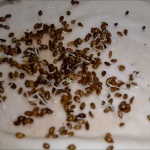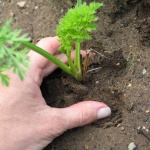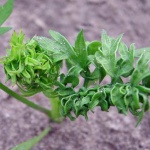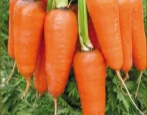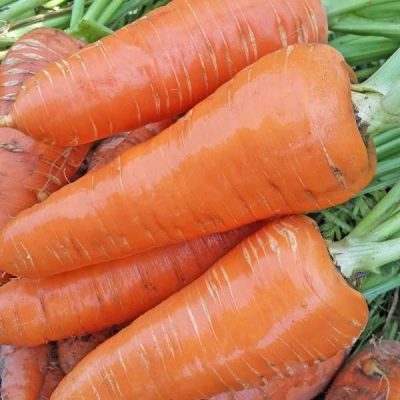
- Year of approval: 1950
- Appointment: for fresh consumption, for canning, for making juice
- Weight, g: 100-170
- The form : conical, obtuse
- Taste qualities: excellent
- Ripening terms: mid-season
- Growing regions: Northwest, Central, Middle Volga, Far Eastern, North Caucasian
- Length, cm: up to 16
- Diameter, cm: 5
- Bark coloration: orange
When choosing a carrot variety for planting on a garden ridge, many vegetable growers prefer time-tested varieties, for example, Moscow winter A 515. This type is unpretentious in care, quickly adapts to growing conditions, and also gives high and stable yields. It's easy to grow a vegetable, the main thing is to get acquainted with the intricacies of agricultural technology.
Breeding history
The mid-ripening Moscow winter carrot A 515 was bred by scientists from the Federal Research Center of Vegetable Growing in 1943. 7 years later, in 1950, the vegetable crop was entered into the State Register of approved for use. Carrots are cultivated in the North-West, Central, Far East, North Caucasus and Middle Volga regions. You can grow carrots both on garden ridges and on farmlands. In addition, the variety is happily grown by the gardeners of Moldova and Ukraine.
Description of the variety
Moscow winter A 515 is a plant with a powerful rosette with spreading foliage. The leaves of the tops are long (up to 25-30 cm), emerald green in color, with a strong dissection of the edge. The foliage does not have a characteristic aroma.
This species belongs to the Chantenay cultivar. The carrot variety is characterized by resistance to cracking and flowering. Ripe roots protrude slightly above the soil surface, which simplifies the harvesting process.
Characteristics of the appearance of the plant and root crops
This variety is medium-sized. Root crops are all leveled and neat, so carrots are often grown commercially. The average weight of a vegetable is 100-170 grams. The length of the specimen does not exceed 16 cm, and the diameter is about 5 cm.
The shape of the root crops is conical or elongated-conical with a rounded "nose". The bark of the vegetable is thin, smooth, with a noticeable gloss, without irregularities. On the surface, sometimes shallow eyes and a few light-colored filamentous roots can be noted. Ripe carrots have a uniform bright orange color.
The dug up crop tolerates long transportations without losses. In addition, the variety is endowed with long shelf life, so the carrots are ideal for winter storage.
Purpose and taste of tubers
Moscow winter A 515 is a vegetable that is remembered for its excellent taste. The orange pulp is characterized by a moderately dense, tender, crispy and juicy consistency, without fiber and bitterness. The taste is dominated by pleasant sweetness, light sugariness, complemented by a carrot aroma. The core of the root crops is thin, practically not differing in color from the pulp.
Carrots are endowed with versatility of purpose - they are eaten fresh, added to salads, cold and hot dishes, frozen, used for canning vegetables, and also used as a preparation for the winter period. Some housewives point out that the variety is ideal for processing on mashed potatoes and juices.
Maturation
Moscow winter A 515 is a mid-season variety.The growing season lasts 110-120 days. You can evaluate the taste of root vegetables after 70 days, and full ripening occurs later. Mass harvesting occurs at the end of August, September.
Yield
The yield indicators for the variety are excellent. On average, 5-7 kg of juicy specimens can be collected from 1 m2 of plantings. When growing a vegetable for sale or industrial processing, up to 60 tons of carrots are dug out from 1 hectare of plantations. The maximum yield was recorded at around 100 t / ha.
Growing and care
Carrots are planted in late April - early May. Seeds are pre-disinfected. Before sowing, grooves are made on the site with a depth of 1.5-2 cm. The distance between rows is 15-20 cm. Planting is carried out according to the scheme 5-7 by 15-20 cm. The best predecessors for this crop are: onions, tomatoes and cucumbers.
For podzimnogo cultivation, sowing seeds is carried out at the end of October, at a temperature of + 4 ... 5 degrees.
The agricultural technology of the vegetable is not particularly different from other carrot varieties: regular watering, applying dressings three times per season, thinning (2 times), loosening and weeding the soil, as well as preventing viruses.
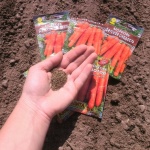
Carrots are one of the most unpretentious crops in terms of growing conditions; they can endure a short drought and a short cold snap. However, to get tasty and large root crops, you should adhere to the basic rules for planting carrots.


Soil requirements
It is comfortable for carrots to grow in light loam or sandy loam, which are fertilized, moisturized, breathable, and also have a neutral acidity level. In addition, the vegetable develops well, growing in substrates saturated with humus.
Required climatic conditions
The plant is thermophilic, resistant to minor temperature fluctuations, but vulnerable to shade and drought. The site should be chosen sunny, warm and bright.
Disease and pest resistance
Due to its high immunity, the culture is rarely exposed to diseases and pests.

Carrots grow in almost any garden. There is an opinion that this culture is very resistant to all kinds of diseases and pests, but this is not the case. Without proper care, carrots become susceptible to all kinds of infections and are affected by harmful insects.


